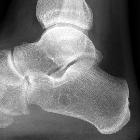Skeletal "do not touch" lesions

Leave alone
lesions - skeletal • Sclerotic non-ossifying fibroma - Ganzer Fall bei Radiopaedia

Leave alone
lesions - skeletal • Osteopoikilosis - Ganzer Fall bei Radiopaedia

Leave alone
lesions - skeletal • Tug lesion - soleal line - Ganzer Fall bei Radiopaedia

Leave alone
lesions - skeletal • Cortical desmoid - Ganzer Fall bei Radiopaedia

Leave alone
lesions - skeletal • Synovial herniation pit - growing - Ganzer Fall bei Radiopaedia
Skeletal “do not touch” lesions (also called leave me alone lesions) are so characteristic radiographically, that further diagnostic tests such as a biopsy are unnecessary and can be frankly misleading and lead to additional unnecessary surgery. Thus a radiologic diagnosis should be made without a list of differential possibilities.
These lesions can be classified into three categories:
Post-traumatic lesions
- avulsion injury
- myositis ossificans
- discogenic vertebral sclerosis
- pseudodislocation of the humerus
- geodes or subchondral cysts near joints
- fracture (with extensive osteosclerosis and periostitis) can mimic a bone tumor
- costochondritis / Tietze syndrome
Normal variants
Lesions that are real but obviously benign
- non-ossifying fibroma
- bone island (enostoses)
- pelvic digit / rib
- unicameral bone cysts
- bone infarction
- Pitt pit (synovial herniation pit)
- pseudotumor of the calcaneus
- osteopoikilosis
- tug lesion e.g. cortical desmoid
Siehe auch:

 Assoziationen und Differentialdiagnosen zu skelettale "do not touch"-Läsionen:
Assoziationen und Differentialdiagnosen zu skelettale "do not touch"-Läsionen:








